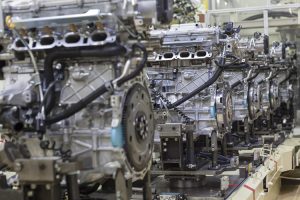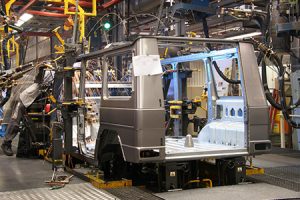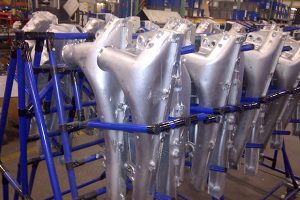 What do automotive companies mean by ‘logistics’ and ‘supply chain’? Automotive Logistics looks at whether OEM and supplier organisations reflect the sector’s changing demands and technology
What do automotive companies mean by ‘logistics’ and ‘supply chain’? Automotive Logistics looks at whether OEM and supplier organisations reflect the sector’s changing demands and technology
The logic is clear: it doesn’t matter how efficient your factories and delivery networks are if they are churning out products nobody wants to buy. In many sectors, the challenge of steering huge, complex production systems to hit the narrow, fast-moving target of consumer demand is a growing preoccupation.
Consumer goods companies live and die by shelf availability, for example. Put too little product in stores and fickle customers will simply pick up a competitor’s offering. Too much, and it will probably be thrown away. To boot, more and more customers may simply browse the store to find products they will then buy online. As a result, many companies are investing huge sums in ‘demand sensing’ systems that combine data from sales teams, supermarket tills, weather forecasts and a host of other sources to determine production schedules, inventory levels and distribution plans.
The automotive industry learned a hard lesson about supply-demand mismatch at the beginning of the 2008 recession, as anything from disused airfields to floating ships filled up with excess vehicle stock. It has more than its share of everyday challenges too, with a proliferation of models, options, customers, suppliers and production locations spanning the globe.
Boiled down to basics, automotive companies have three options as they try to ensure that supply meets demand across these complex networks. They can pay the price themselves, with profits squeezed under the weight of high inventories or spiralling production and logistics costs; they can make their customers pay, forcing them to choose between long lead times or products they don’t really want; or, they can get smarter.
Six mega-processes of supply chain managementSupply chain management (SCM) is the shorthand term for those efforts to get smarter. Gene Tyndall, executive vice-president of global supply chain consultancy Tompkins International, explains that effective SCM requires the integration and tight coordination of “six mega-processes: plan, buy, make, move, distribute and sell”.
However, despite its undoubted importance, the fundamental principles of SCM are still widely misunderstood, says Tyndall. “Many of its related terms are confused or used interchangeably, and logistics is one of them. Logistics is the movement and storage of material and products within and across any of those six processes – and that’s complicated enough – but even 3PLs sometimes use the term ‘supply chain’ when they actually mean ‘logistics’.”

True supply chain management means thinking, planning and operating in an integrated way across all six processes, and that’s an area where the automotive industry still lags behind other sectors, says Tyndall, a veteran SCM consultant and a former executive at Ryder System. With a few notable exceptions, automotive companies have not historically had a chief supply chain officer, he points out. Traditionally, the closest thing to a supply chain function in many automotive companies has been ‘materials planning and logistics’, but that falls short because “the supply chain also includes an operations and business strategy element. It’s about how you execute to enable your company’s business strategy.”
Similarly, many automotive companies have separated their procurement activities from the supply chain, Tyndall adds.
The six mega-processes don’t have to be the responsibility of, or included within, a single function, provided the functions that are responsible are working sufficiently closely together. But even this coordination has been less than optimal in many automotive businesses. Tyndall cites the example of ‘sales and operations planning’, or S&OP, which is the regular cadence of planning meetings between the commercial and operational functions that form the basis of demand and supply processes at many consumer goods organisations. The automotive industry traditionally doesn’t do formal S&OP, he notes. That failure to coordinate effectively “leaves money on the table”, with companies “ordering too many parts, locating them in the wrong place, or running out of stock.”
If the automotive industry has been slow to optimise its SCM processes, it is at least recognising the need to do so now, says Tyndall. While General Motors had traditionally separated its transport and packaging purchasing and operations from its broader plant and supplier operations, the carmaker has recently made an organisational change to take a more integrated, end-to-end approach to planning and operations in the supply chain.
“The changes started when the carmakers realised they needed to bring order-to-delivery times down, and to do so required them to get people together to work in a cross-functional way,” says Tyndall.
 An effective combination of people, processes and technology is required to deliver strong supply chain management
An effective combination of people, processes and technology is required to deliver strong supply chain managementThe most important components of strong supply chain management are people, processes and technology, says Tyndall. The good news for automotive companies is that at least two of those elements are now more common than they once were. Sophisticated software solutions are available ‘off the shelf’, for example, and IT systems are more easily integrated than a decade ago. Processes are better understood too, with ‘reference models’ like the APICS Supply Chain Council’s ‘SCOR’ (Supply Chain Operations Reference), available to any organisation that wants it, and consultancies that can help companies adapt best practices and technologies to suit the needs of their own operations.
That leaves people, which is where the main challenge lies. Integrated supply chains require people with the right skills, attitudes and mindsets to plan across the operations of the business, and getting that right requires a combination of recruitment, training and change management.
One company that has seen significant changes in its approach to the supply chain function – both in semantics and its organisation – is tier one supplier Continental. “In 2012, we changed the name of our corporate function from ‘logistics’, to ‘supply chain management’,” explains Andreas Subbe, director of logistics SCMA (supply chain management automotive) for Asia Pacific. “At the same time, the function was elevated within the organisation. It used to be linked to production; it is now linked to the CEO.”
Much of the incentive for that change came as a result of the supply chain disruptions caused by natural disasters, especially in Asia, where the company has 26 automotive production locations in nine countries.
 A supply chain that clears inventory from the line side but stacks it up in supplier warehouses may not be as lean as would first appear
A supply chain that clears inventory from the line side but stacks it up in supplier warehouses may not be as lean as would first appear“We understood that we need to have a ‘plan B’ when problems occur,” says Subbe. Getting that required considerable expansion in the responsibilities of the new supply chain organisation, with an increased focus on network design, risk management and other strategic considerations.
To fulfil its new responsibilities, Continental’s supply chain organisation has made changes to its people, processes and supplier relationships. “We are always hiring new people and there is a big emphasis on training and development,” says Subbe. “Members of the logistics team might be the last person in contact with the customer [before product handover], so they need the right skill-sets.”
Getting, and keeping, the right capabilities is always challenging, especially in Asia where staff turnover rates can be higher than elsewhere in the world. Subbe notes that the company offers more than 200 courses on supply chain topics for its employees.
Internally, Continental’s supply chain organisation has altered its relationship with other functions, for example through a particularly close integration with the sourcing organisation and a stronger input into network planning decisions, with transport considerations considered alongside labour costs. Externally, the new approach has altered the company’s attitude to outsourcing, especially in logistics. “You can outsource forwarding activities, but we are probably insourcing more activities now as we want the knowledge,” says Subbe. “Overall, we are moving towards closer, more strategic partnerships with fewer logistics providers.”
At tier supplier and contract vehicle manufacturer Magna Steyr, Michael Druml, global director for purchasing and logistics, emphasises the necessity of an integrated approach. “In any organisation, you naturally have conflicts between departments” he says. “The guy responsible for inventory wants to bring it down, but the transport guy wants to optimise logistics costs. So I see the advantage of putting those functions together.” Druml’s role, therefore, encompasses global activities related to the end-to-end supply chain, from the engineering of the part to the supply of spare parts, and everything in between.
With plenty of suppliers located a long distance from Magna Steyr’s manufacturing sites, including its assembly plant in Graz, Austria, logistics costs are already a significant consideration in its supply chain calculations, but Druml notes that supply chain optimisation can’t stop at the factory loading dock.
“One of the important new challenges for us is the move from thinking about landed cost to line-side cost,” he says. In part, that change is being driven by technical advances, with the emergence of new forms of automation, like the use of automated guided vehicles to deliver parts directly to the line. Much of the potential advantage of such technologies is lost, he says, if a manufacturer has to do a lot of sorting at the dock; instead, more planning activity needs to be considered back at suppliers.
Coordination is keyOf course, companies don’t need a named supply chain function organisation to pursue the goals of greater integration and tighter coordination. At truckmaker Scania, responsibility for supply chain activities is devolved to separate functions, including production, purchasing and logistics. But, says Fabio Castello, vice-president of logistics for Latin America, what matters most is how those functions interact.
Scania ensures tight coordination between functions through regular ‘pulse’ meetings, which take place every day or week. “At those meetings, we follow up on previously agreed actions, describe our ongoing activities and report deviations,” says Castello. It’s an approach that works well, he says, allowing members of different functions to respect each other’s role, and to decide in detail what needs to happen next.
The company also has two big forums where strategic issues are discussed and decided on a cross-functional basis: a sourcing board, headed by purchasing, and an operational board, headed by logistics. These forums have existed for many years, points out Castello, but their use is increasing all the time as the company seeks to continually improve its overall supply chain performance.
Scania also has a clear mission to integrate and standardise processes between its own plants, and increasingly those of other Volkswagen Group brands. The aim is to avoid different parts of the group simultaneously developing solutions for the same challenges and to ensure best practices are quickly shared. The technology for this integration is not rocket science, he adds, citing frequent video conferences between different companies in the group and the adoption of shared standards. However, the outcomes are real and useful.
Scania, for example, is currently trialling pick-by-light technology in its warehouses. In evaluating potential suppliers, it was able to draw upon work already conducted by another company within the group. There are plenty of opportunities for best-practice sharing, says Castello. “While the parts you are talking about may be very different, such as a small bracket for a car or a 50ft (15.2-metre) side member for a bus, it’s amazing how similar our challenges are.”
 Technology clearly has an important role to play in meeting the demands of tomorrow's logistics and supply chain managers
Technology clearly has an important role to play in meeting the demands of tomorrow's logistics and supply chain managersTier one supplier Johnson Controls is another organisation putting even greater emphasis on adopting standard processes and tools to drive supply chain performance improvement. Frank Vorrath, the company’s vice-president of global supply chain, explains that supply chain excellence is a key function for the company alongside manufacturing, engineering, marketing and sales, and procurement. “The journey to supply chain excellence is not a project, it is a transformation to attain world-class performance,” he says.
To help navigate that journey, Johnson Controls has partnered with external strategic partners to develop its own supply chain maturity model, which, Vorrath says, will build capabilities using standardised principles, objectives and processes, as well as focus on technology and people. The supply chain maturity model will assess current supply chain capabilities across its businesses, identify gaps, set improvement targets and create action plans for ongoing improvement.
To support the development of skills needed to attain supply chain excellence, Johnson Controls is establishing a supply chain academy where those from across the organisation can receive training aligned with specific supply chain learning objectives, according to their functions and roles.
“Within the next 3-5 years, we expect Johnson Controls to achieve supply chain excellence and then to continue advancing our capabilities in this area,” Vorrath says. “That’s essential to the Johnson Controls vision of becoming the most operationally capable company in the world.”
Vorrath predicts that supply chain requirements will rise exponentially by 2020 and beyond, as customer expectations and the emergence of new technologies reshape the sector. “In the future, you won’t be competing company-against-company. All companies will be part of an ecosystem and you have to make sure to be part of the strongest one.”
A competitive advantage, Vorrath says, will come from the creation of ecosystems that deliver a world-class, end-to-end customer experience that results in more value for the end customer; this will require an ever-increasing emphasis on collaboration and integration between companies as well as within them.
Technological and cultural changes about the nature of the car itself will also transport the supply chain, predicts Gerry Mattios, expert principal in Beijing at consultancy Bain & Company. Just as customers now expect their mobile phones to gain new features over time, Mattios suggests the ability to deliver new features via software upgrades, as Tesla is already doing with its vehicles, or even to swap modules in or out over the lifetime of the car, will change the interaction between manufacturers and their customers.
 Standard processes like handling and packaging are also key to improving supply chain performance
Standard processes like handling and packaging are also key to improving supply chain performanceAs this ability to upgrade and improve extends the lifespan of the basic vehicle, carmakers will need to move away from their current focus on periodic replacement and create new, ongoing relationships with customers. This, in turn, will require OEMs to think and act more like retailers and consumer goods companies than they do today. Mattios says that carmakers should try to learn from the supply chains of the retail industry, including at Apple, Alibaba and Amazon. They might even have to abandon the concept of the supply chain altogether, he notes, with a move towards “supply circles”, which place equal emphasis on the flow of products or components back from the customer for upgrade, remanufacture or recycling.
Such seismic shifts are still a ways off, and for companies still struggling to make today’s supply chains work in a more integrated way, Gene Tyndall offers some straightforward advice: “Set up a ‘supply chain pilot’ of something, start with the customer and work backwards, focusing on your demand planning and your supply planning to match. Do that well and you can’t help but touch all six critical supply chain processes, discover the hand-offs, and find savings and improvements in speed and effectiveness.”
This exercise will also point out the need for an overall operations strategy to drive the supply chain. And in time, the change to ‘supply chain management’ should, hopefully, mean more than just words.
"In the future, you won’t be competing company-against-company. All companies will be part of an ecosystem and you have to make sure to be part of the strongest one." - Frank Vorrath, Johnson Controls

























![Global[1]](https://d3n5uof8vony13.cloudfront.net/Pictures/web/a/d/s/global1_726550.svgz)










